Study of Mechanical Properties of an Eco-Friendly Concrete Containing Recycled Carbon Fiber Reinforced Polymer and Recycled Aggregate
Abstract
:1. Introduction
2. Materials and Test Methods
2.1. Materials
2.2. Mix Design
2.3. Sample Preparation
2.4. Test Methods
2.4.1. Slump Test
2.4.2. Compressive Strength Test
2.4.3. Flexural Test
3. Results and Discussion
3.1. Flowability
3.2. Compressive Strength
3.3. Flexural Performance
3.3.1. Load–Deflection Curve
3.3.2. Flexural Strength
3.3.3. Flexural Stiffness
3.3.4. Flexural Toughness and Residual Load-Bearing Capacity
4. Conclusions
- (1)
- The addition of RCFRP and RA decreases the flowability of concrete. Specifically, the slump value of specimen RA20RF15 (with 20% of RA replacement rate and 1.5% volume content of RCFRP fibers) is 36.0% less than that of the plain concrete specimen RA0RF0.
- (2)
- The proposed concrete composite exhibits similar compressive strength to that of plain concrete. The compressive strength of the fiber-reinforced specimens RA20RF5, RA20RF10, and RA20RF15 are 1.027, 1.005, and 0.958 times that of the reference specimen RA20RF0, respectively.
- (3)
- The addition of RA slightly decreases the flexural strength of concrete. For specimen RA20RF0, the flexural strength dropped by 6.7% compared to that of plain concrete. Nevertheless, the addition of RCFRP can largely enhance the flexural strength of concrete. For example, the flexural strength of specimen RA20RF15 increased by 23.8% compared to that of plain concrete.
- (4)
- The addition RCFRP fibers can significantly improve the flexural toughness and residual load-bearing capacity of concrete. For RFRAC specimens with 0.5%, 1%, and 1.5% of RCFRP fiber addition, the flexural toughness indexes are 1.32, 1.80, and 2.60 times that of the plain concrete specimen. Furthermore, the residual load ratio of specimen RA20RF15 is 0.69, which is significantly improved compared to the residual load ratio of 0.0 for the plain concrete specimen RA0RF0.
- (5)
- The failure patterns of mixes with/without RCFRP fibers are notably different. For the compressive test, the extent of concrete spalling of RFRAC was alleviated compared to RAC and plain concrete mixes, and the RFRAC specimens were still in one piece owing to the bridging action of RCFRP fibers in concrete. For the four-point bending test, the RFRAC specimens remained in good integrity at the ultimate displacement, and the specimen could still sustain the applied load, while the RAC and plain concrete mixes broke into two pieces when a flexural crack occurred.
Author Contributions
Funding
Conflicts of Interest
References
- Huang, X.; Xu, B. On the legal regulation of the reduction and utilization of the construction waste based on eco-efficiency. Urban Stud. 2011, 18, 90–94. (In Chinese) [Google Scholar]
- Tam, V.W.Y.; Soomro, M.; Evangelista, A.C.J. A review of recycled aggregate in concrete applications (2000–2017). Constr. Build. Mater. 2018, 172, 272–292. [Google Scholar] [CrossRef]
- Herrador, R.; Pérez, P.; Garach, L.; Ordóñez, J. Use of Recycled Construction and Demolition Waste Aggregate for Road Course Surfacing. J. Transp. Eng. 2012, 138, 182–190. [Google Scholar] [CrossRef]
- Haider, I.; Cetin, B.; Kaya, Z.; Hatipoglu, M.; Cetin, A.; Aydilek, A.H. Evaluation of the Mechanical Performance of Recycled Concrete Aggregates Used in Highway Base Layers. In Proceedings of the Geo-Congress 2014: Geo-Characterization and Modeling for Sustainability, Atlanta, GA, USA, 23–26 February 2014; pp. 3686–3694. [Google Scholar] [CrossRef]
- Arisha, A.M.; Gabr, A.R.; El-Badawy, S.; Shwally, S.A. Performance Evaluation of Construction and Demolition Waste Materials for Pavement Construction in Egypt. J. Mater. Civ. Eng. 2018, 30, 04017270. [Google Scholar] [CrossRef]
- Tamayo, P.; Pacheco, J.; Thomas, C.; De Brito, J.; Rico, J. Mechanical and Durability Properties of Concrete with Coarse Recycled Aggregate Produced with Electric Arc Furnace Slag Concrete. Appl. Sci. 2019, 10, 216. [Google Scholar] [CrossRef] [Green Version]
- Duarte, G.; Gomes, R.C.C.; De Brito, J.; Bravo, M.; Nobre, J. Economic and Technical Viability of Using Shotcrete with Coarse Recycled Concrete Aggregates in Deep Tunnels. Appl. Sci. 2020, 10, 2697. [Google Scholar] [CrossRef] [Green Version]
- Courard, L.; Rondeux, M.; Zhao, Z.; Michel, F. Use of Recycled Fine Aggregates from C&DW for Unbound Road Sub-Base. Materials 2020, 13, 2994. [Google Scholar] [CrossRef]
- Chong, X.; Sha, H.; Xie, L.; Li, A.; Jiang, Q.; He, Y.; Chen, X. Experimental and Numerical Studies on the Seismic Performance of Precast Concrete Shear Wall Structures with an Energy Dissipation Cladding Panel. J. Earthq. Eng. 2020, 1–16. [Google Scholar] [CrossRef]
- Xie, L.; Yang, C.; Li, A.; Lu, J.; Zeng, D. Experimental investigation of the seismic performance of flexible pipes for seismically isolated buildings. Eng. Struct. 2020, 222, 111132. [Google Scholar] [CrossRef]
- Zong, L.; Fei, Z.; Zhang, S. Permeability of recycled aggregate concrete containing fly ash and clay brick waste. J. Clean. Prod. 2014, 70, 175–182. [Google Scholar] [CrossRef]
- Evangelista, L.; De Brito, J. Mechanical behaviour of concrete made with fine recycled concrete aggregates. Cem. Concr. Compos. 2007, 29, 397–401. [Google Scholar] [CrossRef]
- Kou, S.; Poon, C. Enhancing the durability properties of concrete prepared with coarse recycled aggregate. Constr. Build. Mater. 2012, 35, 69–76. [Google Scholar] [CrossRef]
- Carneiro, J.A.; Lima, P.R.L.; Leite, M.B.; Filho, R.D.T. Compressive stress–strain behavior of steel fiber reinforced-recycled aggregate concrete. Cem. Concr. Compos. 2014, 46, 65–72. [Google Scholar] [CrossRef]
- Akça, K.R.; Çakır, Ö.; Ipek, M. Properties of polypropylene fiber reinforced concrete using recycled aggregates. Constr. Build. Mater. 2015, 98, 620–630. [Google Scholar] [CrossRef]
- Prasad, M.L.V.; Rathish Kumar, P. Strength studies on glass fiber reinforced recycled aggregate concrete. Asian J. Civ. Eng. (Build. Hous.) 2007, 8, 677–690. [Google Scholar]
- Xu, S.; Wu, C.; Liu, Z.; Han, K.; Su, Y.; Zhao, J.; Li, J. Experimental investigation of seismic behavior of ultra-high performance steel fiber reinforced concrete columns. Eng. Struct. 2017, 152, 129–148. [Google Scholar] [CrossRef]
- Huang, L.; Xu, L.; Chi, Y.; Xu, H. Experimental investigation on the seismic performance of steel–polypropylene hybrid fiber reinforced concrete columns. Constr. Build. Mater. 2015, 87, 16–27. [Google Scholar] [CrossRef]
- Li, V.C.; Stang, H.; Krenchel, H. Micromechanics of crack bridging in fibre-reinforced concrete. Mater. Struct. 1993, 26, 486–494. [Google Scholar] [CrossRef]
- Geier, N.; Davim, J.P.; Szalay, T. Advanced cutting tools and technologies for drilling carbon fibre reinforced polymer (CFRP) composites: A review. Compos. Part A: Appl. Sci. Manuf. 2019, 125, 105552. [Google Scholar] [CrossRef]
- Meng, F.; Olivetti, E.; Zhao, Y.; Chang, J.C.; Pickering, S.J.; McKechnie, J. Comparing Life Cycle Energy and Global Warming Potential of Carbon Fiber Composite Recycling Technologies and Waste Management Options. ACS Sustain. Chem. Eng. 2018, 6, 9854–9865. [Google Scholar] [CrossRef]
- Lefeuvre, A.; Garnier, S.; Jacquemin, L.; Pillain, B.; Sonnemann, G. Anticipating in-use stocks of carbon fiber reinforced polymers and related waste flows generated by the commercial aeronautical sector until 2050. Resour. Conserv. Recycl. 2017, 125, 264–272. [Google Scholar] [CrossRef]
- Lefeuvre, A.; Garnier, S.; Jacquemin, L.; Pillain, B.; Sonnemann, G. Anticipating in-use stocks of carbon fibre reinforced polymers and related waste generated by the wind power sector until 2050. Resour. Conserv. Recycl. 2019, 141, 30–39. [Google Scholar] [CrossRef]
- Akbar, A.; Liew, K. Assessing recycling potential of carbon fiber reinforced plastic waste in production of eco-efficient cement-based materials. J. Clean. Prod. 2020, 274, 123001. [Google Scholar] [CrossRef]
- Pimenta, S.; Pinho, S.T. Recycling carbon fibre reinforced polymers for structural applications: Technology review and market outlook. Waste Manag. 2011, 31, 378–392. [Google Scholar] [CrossRef] [PubMed] [Green Version]
- Oliveux, G.; Dandy, L.O.; Leeke, G.A. Current status of recycling of fibre reinforced polymers: Review of technologies, reuse and resulting properties. Prog. Mater. Sci. 2015, 72, 61–99. [Google Scholar] [CrossRef] [Green Version]
- Pillain, B.; Loubet, P.; Pestalozzi, F.; Woidasky, J.; Erriguible, A.; Aymonier, C.; Sonnemann, G. Positioning supercritical solvolysis among innovative recycling and current waste management scenarios for carbon fiber reinforced plastics thanks to comparative life cycle assessment. J. Supercrit. Fluids 2019, 154, 104607. [Google Scholar] [CrossRef]
- Mastali, M.; Dalvand, A.; Sattarifard, A. The impact resistance and mechanical properties of the reinforced self-compacting concrete incorporating recycled CFRP fiber with different lengths and dosages. Compos. Part B Eng. 2017, 112, 74–92. [Google Scholar] [CrossRef]
- Ogi, K.; Shinoda, T.; Mizui, M. Strength in concrete reinforced with recycled CFRP pieces. Compos. Part A Appl. Sci. Manuf. 2005, 36, 893–902. [Google Scholar] [CrossRef]
- GB/T 175–2007. Common Portland Cement; Standards Press of China: Beijing, China, 2007. [Google Scholar]
- GB/T 14684–2011. Sand for Construction; Standards Press of China: Beijing, China, 2011. [Google Scholar]
- GB/T 14685–2011. Pebble and Crushed Stone for Construction; Standards Press of China: Beijing, China, 2011. [Google Scholar]
- GB/T 25177–2010. Recycled Coarse Aggregate for Concrete; Standards Press of China: Beijing, China, 2010. [Google Scholar]
- Poon, C.-S.; Shui, Z.; Lam, L.; Fok, H.; Kou, S. Influence of moisture states of natural and recycled aggregates on the slump and compressive strength of concrete. Cem. Concr. Res. 2004, 34, 31–36. [Google Scholar] [CrossRef]
- Zaetang, Y.; Sata, V.; Wongsa, A.; Chindaprasirt, P. Properties of pervious concrete containing recycled concrete block aggregate and recycled concrete aggregate. Constr. Build. Mater. 2016, 111, 15–21. [Google Scholar] [CrossRef]
- GB/T 50080–2016. Standard for Test Method of Performance on Ordinary Fresh Concrete; China Architecture & Building Press: Beijing, China, 2017. [Google Scholar]
- GB/T 50081–2019. Standard for Test Methods of Concrete Physical and Mechanical Properties; China Architecture & Building Press: Beijing, China, 2019. [Google Scholar]
- Aslani, F.; Kelin, J. Assessment and development of high-performance fibre-reinforced lightweight self-compacting concrete including recycled crumb rubber aggregates exposed to elevated temperatures. J. Clean. Prod. 2018, 200, 1009–1025. [Google Scholar] [CrossRef]
- Aydin, A.C. Self compactability of high volume hybrid fiber reinforced concrete. Constr. Build. Mater. 2007, 21, 1149–1154. [Google Scholar] [CrossRef]
- Chen, B.; Liu, J. Contribution of hybrid fibers on the properties of the high-strength lightweight concrete having good workability. Cem. Concr. Res. 2020, 35, 913–917. [Google Scholar] [CrossRef]
- Martínez-García, R.; I Guerra-Romero, M.; Del Pozo, J.M.M.; De Brito, J.; Juan, A. Recycling Aggregates for Self-Compacting Concrete Production: A Feasible Option. Materials 2020, 13, 868. [Google Scholar] [CrossRef] [PubMed] [Green Version]
- Han, B.; Xiang, T.-Y. Axial compressive stress-strain relation and Poisson effect of structural lightweight aggregate concrete. Constr. Build. Mater. 2017, 146, 338–343. [Google Scholar] [CrossRef]
- Xiong, C.; Li, Q.; Lan, T.; Li, H.; Long, W.; Xing, F. Sustainable use of recycled carbon fiber reinforced polymer and crumb rubber in concrete: Mechanical properties and ecological evaluation. J. Clean. Prod. 2020, 123624. [Google Scholar] [CrossRef]
- Nguyen, D.L.; Kim, D.J.; Ryu, G.S.; Koh, K.T. Size effect on flexural behavior of ultra-high-performance hybrid fiber-reinforced concrete. Compos. Part. B Eng. 2013, 45, 1104–1116. [Google Scholar] [CrossRef]
- Etxeberria, M.; Vázquez, E.; Marí, A.; Barra, M. Influence of amount of recycled coarse aggregates and production process on properties of recycled aggregate concrete. Cem. Concr. Res. 2007, 37, 735–742. [Google Scholar] [CrossRef]
- Zitouni, K.; Djerbi, A.; Mebrouki, A. Study on the Microstructure of the New Paste of Recycled Aggregate Self-Compacting Concrete. Materials 2020, 13, 2114. [Google Scholar] [CrossRef] [PubMed]
- Bai, G.; Zhu, C.; Liu, C.; Liu, B. An evaluation of the recycled aggregate characteristics and the recycled aggregate concrete mechanical properties. Constr. Build. Mater. 2020, 240, 117978. [Google Scholar] [CrossRef]
- Tran, C.T.N.; Li, B. Initial Stiffness of Reinforced Concrete Columns with Moderate Aspect Ratios. Adv. Struct. Eng. 2012, 15, 265–276. [Google Scholar] [CrossRef]
- Behera, M.; Bhattacharyya, S.; Minocha, A.; Deoliya, R.; Maiti, S. Recycled aggregate from C&D waste & its use in concrete—A breakthrough towards sustainability in construction sector: A review. Constr. Build. Mater. 2014, 68, 501–516. [Google Scholar] [CrossRef]
- JGJ/T 221–2010. Technical Specification for Application of Fiber Reinforced Concrete; China Architecture & Building Press: Beijing, China, 2011. [Google Scholar]
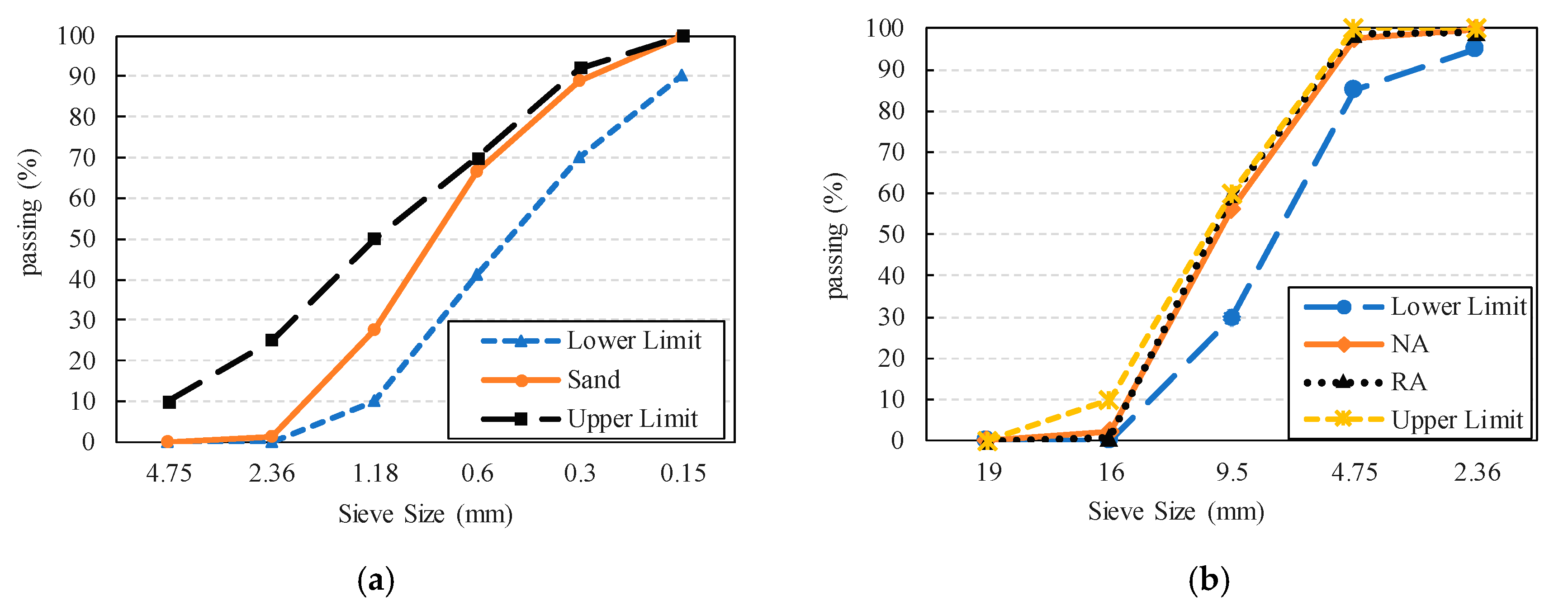
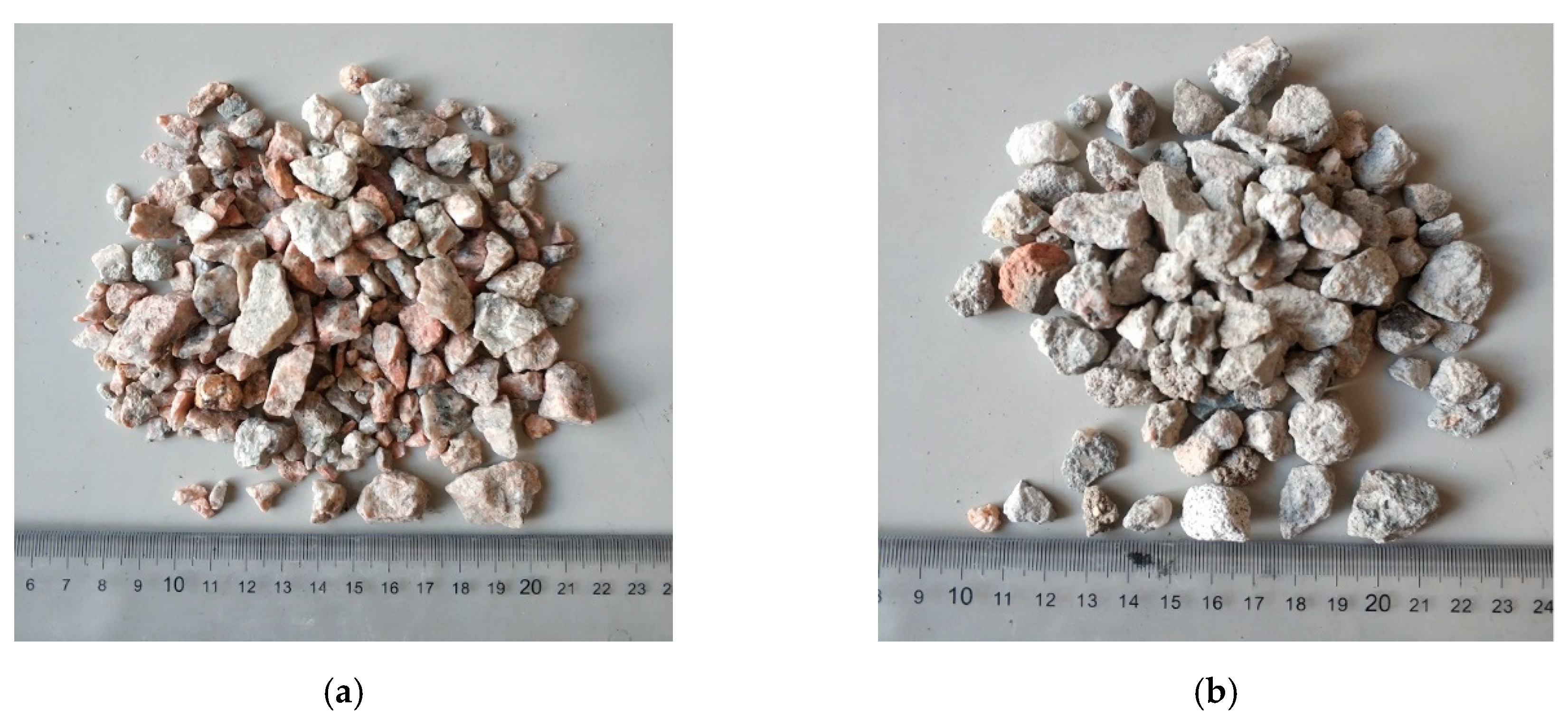
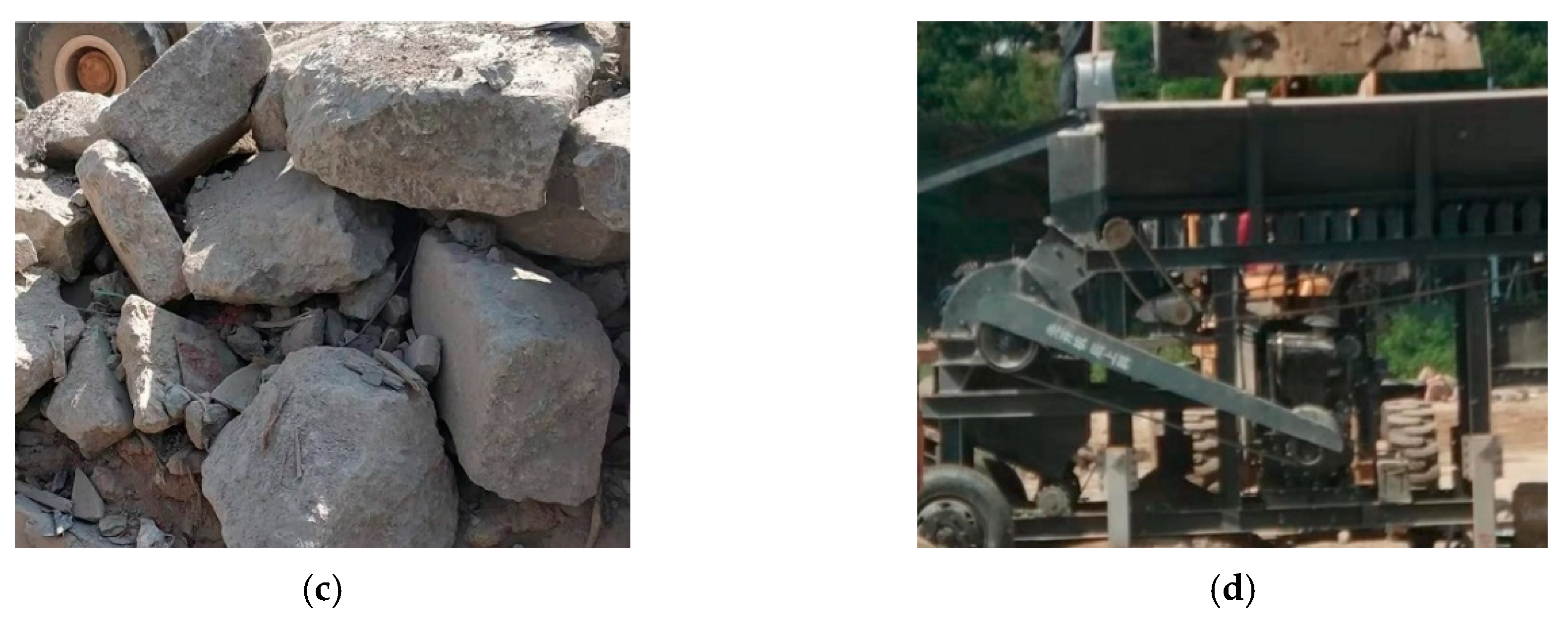

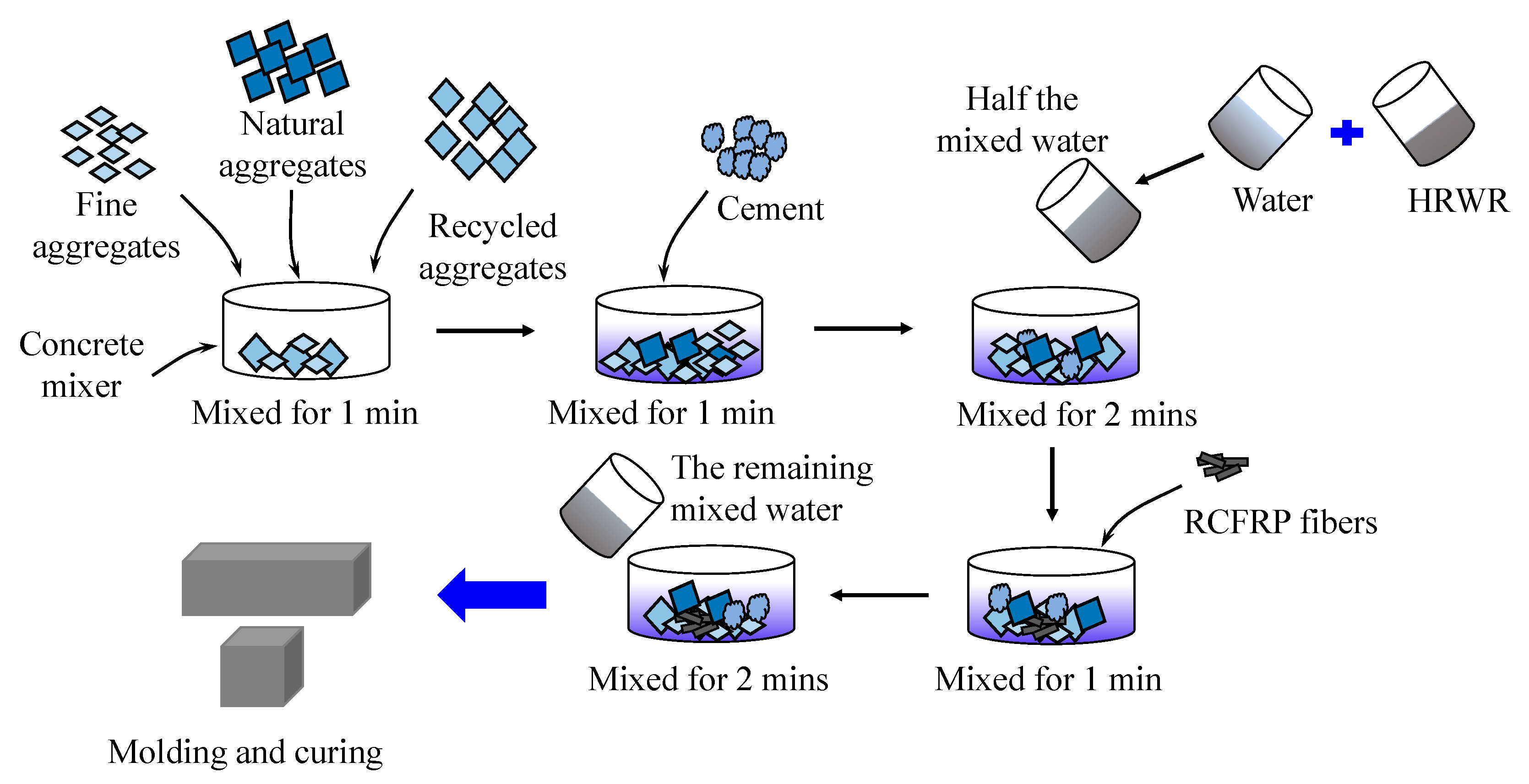

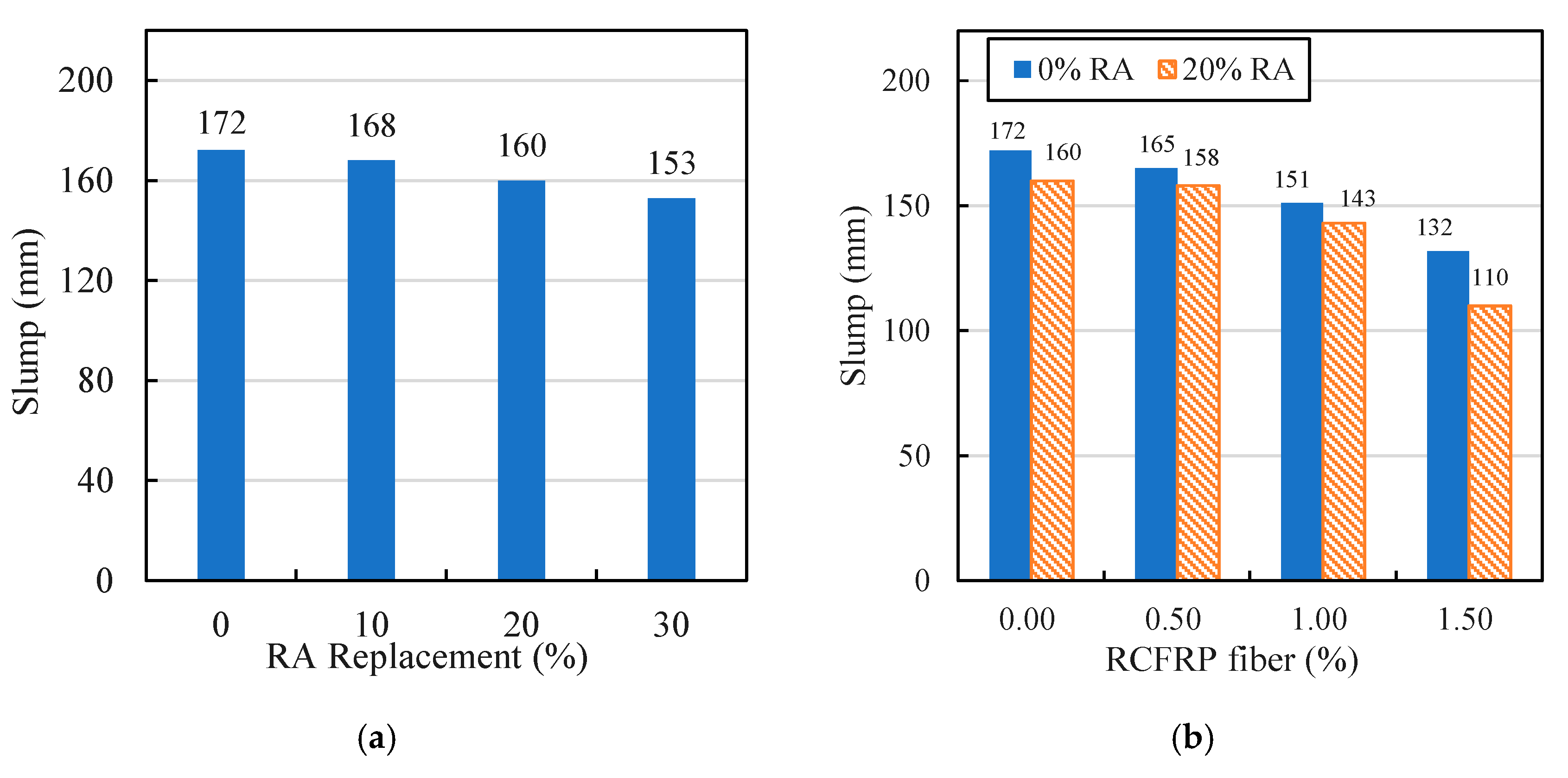
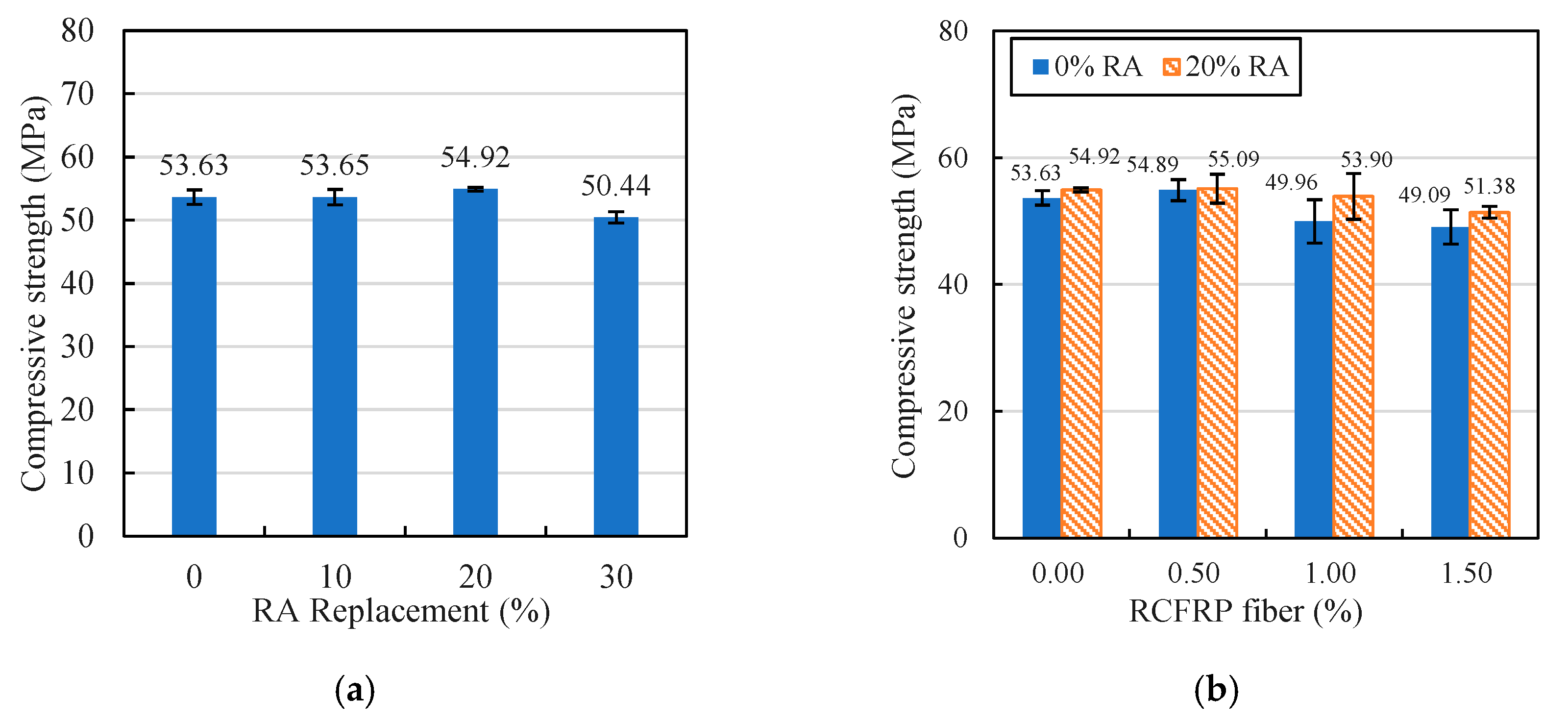



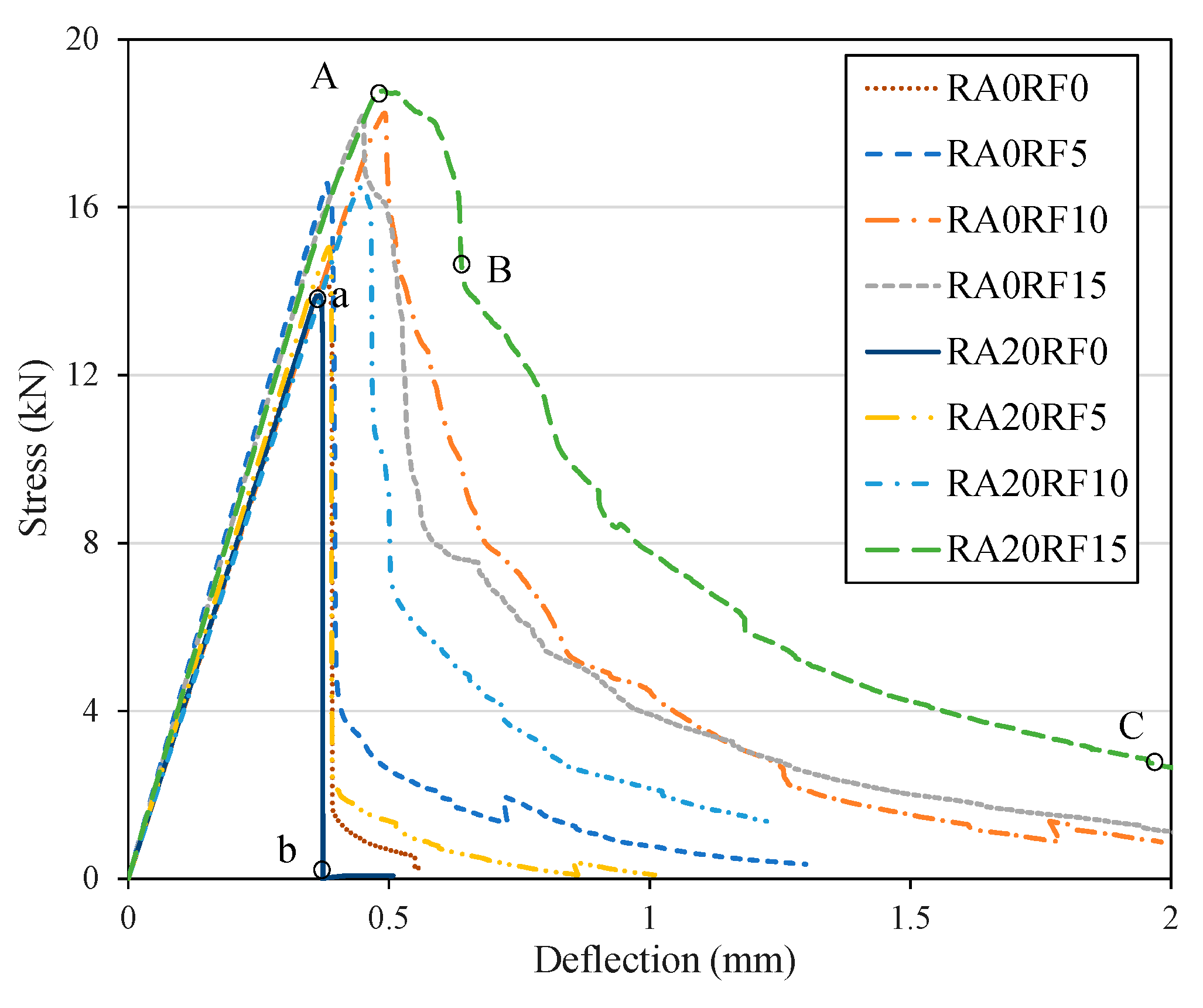

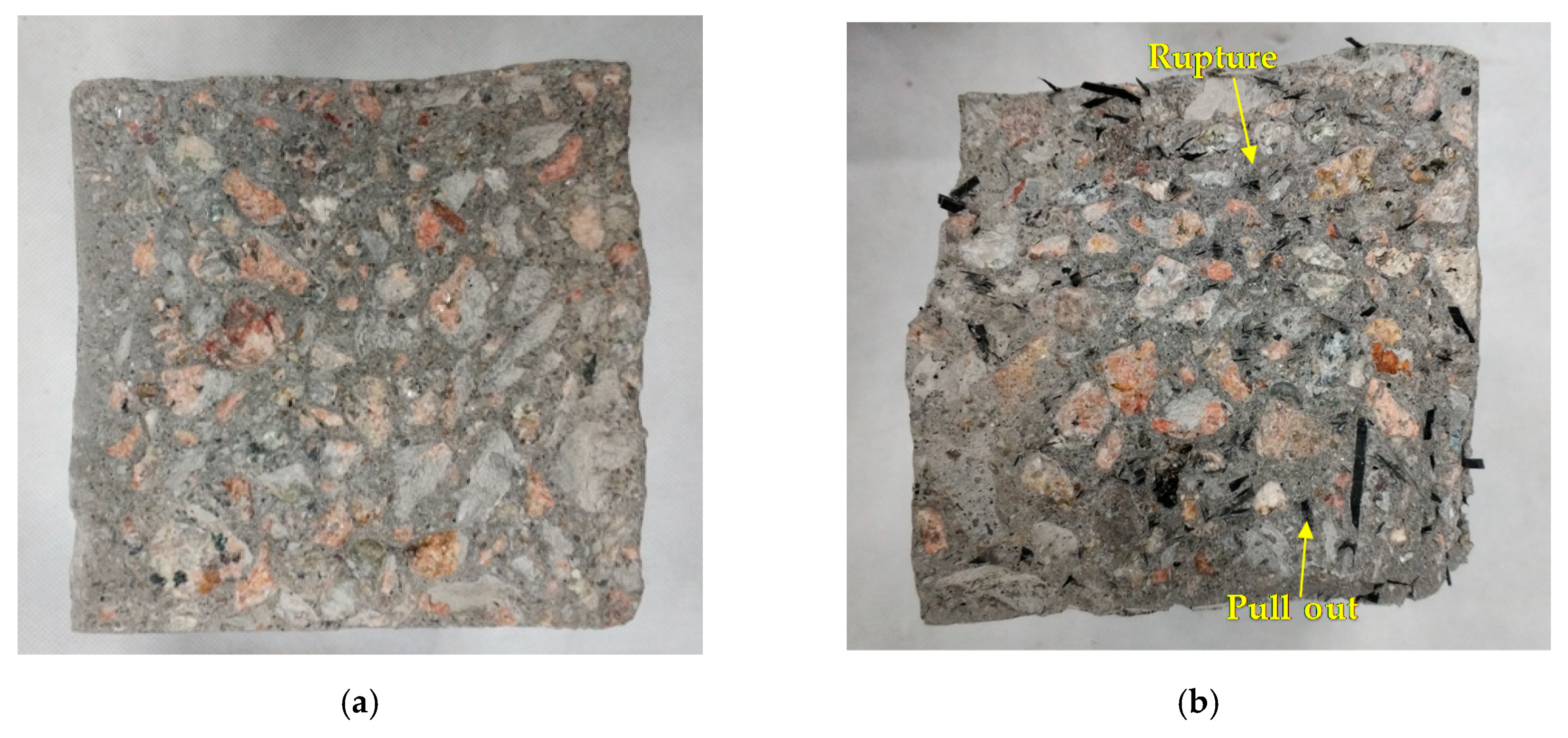



| Ingredient | CaO | SiO2 | Al2O3 | Fe2O3 | MgO | SO3 | K2O | Na2O | LOI |
|---|---|---|---|---|---|---|---|---|---|
| Content (mass %) | 64.42 | 20.52 | 5.62 | 3.78 | 2.11 | 2.10 | 0.28 | 0.20 | 0.87 |
| Material Properties | NA | RA |
|---|---|---|
| Water absorption (%) | 1.44 | 6.02 |
| Apparent density (kg/m3) | 2617 | 2639 |
| Crushing index (%) | 11.36 | 19.49 |
| Sample ID | RCFRP (kg/m3) | NA (kg/m3) | RA (kg/m3) | Sand (kg/m3) | Water (kg/m3) | Cement (kg/m3) | Plasticizer (kg/m3) |
|---|---|---|---|---|---|---|---|
| RA0RF0 | N/A | 1078 | N/A | 590 | 215 | 540 | 1.05 |
| RA10RF0 | N/A | 970.2 | 108.7 | 590 | 215 | 540 | 1.05 |
| RA20RF0 | N/A | 862.4 | 217.4 | 590 | 215 | 540 | 1.05 |
| RA30RF0 | N/A | 754.6 | 326.1 | 590 | 215 | 540 | 1.05 |
| RA0RF5 | 8.5 | 1072.64 | N/A | 587.06 | 213.93 | 537.31 | 1.04 |
| RA0RF10 | 17.0 | 1067.33 | N/A | 584.16 | 212.87 | 534.65 | 1.04 |
| RA0RF15 | 25.5 | 1062.07 | N/A | 581.28 | 211.82 | 532.02 | 1.03 |
| RA20RF5 | 8.5 | 858.11 | 216.32 | 587.06 | 213.93 | 537.31 | 1.04 |
| RA20RF10 | 17.0 | 853.86 | 215.25 | 584.16 | 212.87 | 534.65 | 1.04 |
| RA20RF15 | 25.5 | 849.66 | 214.19 | 581.28 | 211.82 | 532.02 | 1.03 |
Publisher’s Note: MDPI stays neutral with regard to jurisdictional claims in published maps and institutional affiliations. |
© 2020 by the authors. Licensee MDPI, Basel, Switzerland. This article is an open access article distributed under the terms and conditions of the Creative Commons Attribution (CC BY) license (http://creativecommons.org/licenses/by/4.0/).
Share and Cite
Xiong, C.; Lan, T.; Li, Q.; Li, H.; Long, W. Study of Mechanical Properties of an Eco-Friendly Concrete Containing Recycled Carbon Fiber Reinforced Polymer and Recycled Aggregate. Materials 2020, 13, 4592. https://doi.org/10.3390/ma13204592
Xiong C, Lan T, Li Q, Li H, Long W. Study of Mechanical Properties of an Eco-Friendly Concrete Containing Recycled Carbon Fiber Reinforced Polymer and Recycled Aggregate. Materials. 2020; 13(20):4592. https://doi.org/10.3390/ma13204592
Chicago/Turabian StyleXiong, Chen, Tianhao Lan, Qiangsheng Li, Haodao Li, and Wujian Long. 2020. "Study of Mechanical Properties of an Eco-Friendly Concrete Containing Recycled Carbon Fiber Reinforced Polymer and Recycled Aggregate" Materials 13, no. 20: 4592. https://doi.org/10.3390/ma13204592





